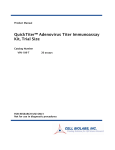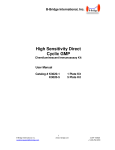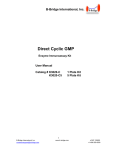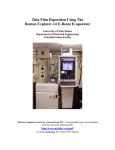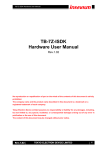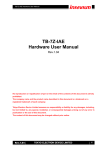Download Nitric Oxide Colorimetric Detection Kit - B
Transcript
B-Bridge International, Inc. Nitric Oxide Colorimetric Detection Kit User Manual Catalog# K3023-1 1 B-Bridge International, Inc. Nitric Oxide 041812 TABLE OF CONTENTS Intended Use 3 Background 3 Assay Principle 3 Kit Components 4 Materials Required 4 Precautions 4 Reagent Preparation 5 Sample Preparation 6 Assay Protocol 6 Calculations 7 Typical Data: Example 7 Typical Standard Curve: Example 8 Notice to Purchaser This product is to be used for Research Purposes Only. It is not to be used for Drug or Diagnostic Purposes, nor is it intended for Human Use. B-Bridge products may not be resold, modified for resale, or used to manufacture commercial products without the express written consent of B-Bridge International, Inc. EXCEPT AS OTHERWISE EXPRESSLY SET FORTH IN THIS USER MANUAL, B-BRIDGE DOES NOT MAKE ANY REPRESENTATION OR WARRANTIES OR CONDITIONS OF ANY KIND, EITHER EXPRESSED OR IMPLIED, WITH RESPECT TO THE PRODUCTS, OR INFORMATION DISCLOSED HEREUNDER, INCLUDING, BUT NOT LIMITED TO, THE IMPLIED WARRANTIES OF MERCHANTABILITY, FIT FOR A PARTICULAR PURPOSE, OR NONINFRINGEMENT OF THE INTELLECTUAL PROPERTY RIGHTS OF THIRD PARTIES. B-Bridge International, Inc. All Rights Reserved. 2 B-Bridge International, Inc. Nitric Oxide 041812 INTENDED USE The B-Bridge Nitric Oxide Detection Kit (catalog # K3023-1) quantitatively measure Nitrate and Nitrite present in serum, plasma, urine, and saliva, as well as water and buffer samples. Tris, HEPES, and PBS buffers are compatible at pH 7.2, as is EDTA at ≤ 10 mM. Detergents such as Triton X-100, Tween 20 and CHAPS are compatible at concentrations of ≤ 0.1%. Most cell lysates and tissue homogenates should also be compatible. Samples containing these detergents should be diluted at least 1:2 with the Assay Buffer. Samples containing SDS or azide are not compatible with the assay. Please read the complete kit insert before performing this assay. This kit is species independent. BACKGROUND Nitric oxide (NO) is a diffusible, transient, reactive molecule that has physiological effects in the picomolar-to-micromolar range. Acting through soluble guanylate cyclase activation, NO is an important physiological regulator of the cardiovascular, nervous, and immunological systems. NO is bio-available by two routes. It can be endogenously generated by constitutive or induced enzymes like Nitric Oxide Synthase or it can be orally ingested as nitrates / nitrites for rapid uptake into circulation and subsequent conversion. The reactive nature of nitric oxide allows it to act as a cytotoxic factor when released during an immune response by cells such as macrophages. The reactivity also allows NO to be easily converted to a toxic radical that can produce nitrosative damage to cells, organelles and molecules such as DNA. Nitrosaylation however can be a regulated post-translational modification in cell signaling. The balance and dynamics of the regulatory/damage facets of NO are major forces in mitochondrial signaling and dysfunction. NO is linked not only to coronary heart disease, endothelial dysfunctions, erectile dysfunction, and neurological disorders, but also diabetes, chronic periodontitis, autism, cancer, and assorted age-related diseases. The physical properties of Nitric Oxide make it challenging for direct detection methods. However, colorimetric methods can be applied to measure its stable break-down products nitrate (-NO3) and nitrite (-NO2). ASSAY PRINCIPLE The B-Bridge Nitric Oxide Detection Kit is designed to quantitatively measure Nitrate and Nitrite present in a variety of samples. Nitric Oxide content is derived from the sum of Nitrate (-NO3) and Nitrite (-NO2). Please read the complete kit insert before performing this assay. Both Nitrate and Nitrite standards are provided to generate standard curves for the assay and all samples should be read off the appropriate standard curve. For Nitrite detection: 1. Samples are mixed with the Color Reagents A and B and incubated at room temperature for 5 minutes. 2. The colored product is read at 550 – 570 nm. 3. The concentration of Nitrite in the sample is calculated, after making a suitable correction for any dilution of the sample, using software available with most plate readers. For total Nitric Oxide content: 1. After the sample is incubated with Nitrate Reductase and NADH. The reductase in combination with NADH reduces Nitrate to Nitrite. 2. After a 20 minute incubation at room temperature, Color Reagents A and B are added and incubated at room temperature for 5 minutes. 3. The colored product is read and calculated as with the Nitrate determination above. The concentration of Nitrate in the sample is calculated by subtracting the measured Nitrite concentration from the Total Nitric Oxide concentration for the sample. This kit uses Nitrate and Nitrite Standard solutions calibrated to the US National Institute for Science and Technology Standard Reference Materials and ISO/IEC standards. 3 B-Bridge International, Inc. Nitric Oxide 041812 KIT COMPONENTS Clear 96-well plate Two Plates Nitrate Standard (2,000uM) 200 uL Nitrite Standard (2,000uM) 200 uL Assay Buffer 60 mL NADH Concentrate 1.2 mL Nitrate Reductase (as a stable solid) 1 vial Enzyme Stabilization Buffer 1 mL Color Reagent A - A solution of Sulfanilamide in acid. CAUSTIC 5 mL Color Reagent B 5 mL - A solution of N-(1-Naphthyl)ethylenediamine in acid. CAUSTIC Store above components at 4°C. Once reconstituted, the Nitrate Reductase must be stored at -20°C. MATERIALS REQUIRED BUT NOT SUPPLIED - Distilled or deionized water free of detectable nitrate or nitrite. - 10,000 Molecular Weight Cut Off (MWCO) polysulfone filters (Corning Spin-X UF 500, 431478) or similar product. - Repeater pipets using disposable tips for addition of Color Reagents A & B, NADH and Nitrate Reductase. - 96 well plate reader capable of reading optical absorption at 540-570 nm. - Software for converting optical density (OD) readings from the plate reader and carrying out four parameter logistic curve (4PLC) fitting. Contact your plate reader manufacturer for details. PRECAUTIONS For in vitro research use only. As with all such products, this kit should only be used by qualified personnel who have had laboratory safety instruction. The complete insert should be read and understood before attempting to use the product. The Color Reagents A and B are both acid solutions and should be handled like any laboratory acid. Wear gloves and laboratory coats when handling materials and, in all cases, please consult your institution’s safety procedures for working with hazardous chemicals. 4 B-Bridge International, Inc. Nitric Oxide 041812 REAGENT PREPARATION Allow the kit reagents to come to room temperature for 30 minutes. Allow the kit reagents to come to room temperature for 30 minutes. We recommend that all standards and samples be run in duplicate to allow the end user to accurately determine NO concentrations. Ensure that all samples have reached room temperature and have been diluted and filtered through a 10,000 MWCO filter prior to running them in the kit. Nitrate Reductase (NR) Allow the desiccator to warm to room temperature. Add 550 µL of Enzyme Stabilization Buffer to the vial. Vortex gently and allow to sit at room temperature for 5 minutes. For extended periods of time (>2 hours) store reconstituted NR on ice. Store any unused reconstituted NR at -20°C. Prepare NR for use in the assay by taking one part of reconstituted NR and adding to three parts of Assay Buffer. See Table below. Reconstituted NR Assay Buffer Total Volume ½ Plate 1 Plate 2 Plates 150 µl 450 µl 600 µl 275 µl 875 µl 1.1 mL 500 µl 1.5 mL 2 mL NADH Preparation Prepare NADH by diluting one part of NADH Concentrate with an equal part of Assay Buffer. Do not store diluted NADH. NADH Concentrate Assay Buffer Total Reaction Volume Mix ½ Plate 1 Plate 2 Plates 300 µl 300 µl 550 µl 550 µl 1 mL 1 mL 600 µl 1.1 mL 2 mL Standard Preparation Nitrate and Nitrite Standards are prepared identically by labeling seven test tubes as #1 through #7. Briefly vortex to mix and then spin the vial of standard in a microcentrifuge to ensure contents are at bottom of vial. - Pipet 360 µL of Assay Buffer into tube 1 and 200 µL into tubes 2 to 7 - Carefully add 40 µL of either the -NO2 or -NO3 Standard to tube #1 and vortex completely - Take 200 µL of the solution in tube #1 and add it to tube #2 and vortex completely - Repeat this for tubes #3 through #7. The concentration of Nitrate or Nitrite in tubes 1 through 7 will be 200, 100, 50, 25, 12.5, 6.25 and 3.125 µM. Use all Standards within 2 hours of preparation. Reagent Assay Buffer -NO2 or -NO3 Standard Standard 1 Standard 2 Standard 3 Standard 4 Standard 5 Standard 6 Final Concentration Standard 1 360 µl 40 µl Standard 2 200 µl Standard 3 200 µl Standard 4 200 µl Standard 5 200 µl Standard 6 200 µl Standard 7 200 µl 200 µl 200 µl 200 µl 200 µl 200 µl 200 µM 100 µM 50 µM 25 µM 12.5 µM 6.25 µM 200 µl 3.125 µM 5 B-Bridge International, Inc. Nitric Oxide 041812 SAMPLE PREPARATION Nitrate/Nitrite is identical across species and this kit will measure NO from sources other than human. This kit will measure NO in cell culture medium, however many media contain nitrate salts. Care needs to be taken in the selection of media when NO measurement is to be done. If samples need to be stored after collection, we recommend storing them at -70°C or lower, preferably after being frozen in liquid nitrogen. This assay has been validated for serum, plasma, urine, and saliva, as well as water and buffer samples. Tris, HEPES, and PBS buffers are compatible at pH 7.2, as is EDTA at ≤ 10 mM. Detergents such as Triton X-100, Tween 20 and CHAPS are compatible at concentrations of ≤ 0.1%. Most cell lysates and tissue homogenates should also be compatible. Samples containing these detergents should be diluted at least 1:2 with the Assay Buffer. Samples containing SDS or azide are not compatible with the assay. Samples containing visible particulate should be centrifuged prior to filtration and using. All samples must be filtered through a 10,000 MWCO spin filter to remove protein. Serum, plasma, saliva, or urine Dilute sample with Assay Buffer and filter through a 10,000 MWCO device following the manufacturer’s recommendations. Collect the filtrates and either further dilute with Assay Buffer as appropriate or use directly in the assay. For serum and plasma, the recommended final dilution is ≥1:4. For urine and saliva, the recommended final dilution is ≥1:8. ASSAY PROTOCOL Standards and samples should be run in duplicate. Use the appropriate standards for either Nitrite (-NO2) or Nitrate (-NO3) determination. All samples should be diluted and filtered through a 10,000 MWCO filter prior to using. Nitrite Determination Protocol 1. Pipet 50 µL of samples or Nitrite standards into duplicate wells in the plate. 2. Pipet 50 µL of Assay Buffer into duplicate wells as the Zero standard. 3. Add 25 µL of the Color Reagent A to each well using a repeater pipet. 4. Add 25 µL of the Color Reagent B to each of well using a repeater pipet. 5. Incubate at room temperature for 5 minutes. 6. Read the optical density at 540-570 nm. These readings are for the Nitrite determination. Total Nitric Oxide Determination Protocol 1. Pipet 50 µL of samples or Nitrate standards into duplicate wells in the plate. 2. Pipet 50 µL of Assay Buffer into duplicate wells as the Zero standard. 3. Add 10 µL of prepared NADH to each well using a repeater pipet. 4. Add 10 µL of prepared NR to each well using a repeater pipet. 5. Incubate at room temperature for 20 minutes. 6. Add 25 µL of the Color Reagent A to each well using a repeater pipet. 7. Add 25 µL of the Color Reagent B to each of well using a repeater pipet. 8. Incubate at room temperature for 5 minutes. 9. Read the optical density at 540-570 nm. These readings are for the Total Nitric Oxide determination. 6 B-Bridge International, Inc. Nitric Oxide 041812 CALCULATIONS Average the duplicate optical density readings for each standard and sample. Create a standard curve by reducing the data using the 4PLC fitting routine on the plate reader, after subtracting the mean ODs for the zero standard. The concentrations obtained should be multiplied by the dilution factor to obtain sample values. Nitrite (-NO2) concentrations are calculated from the data obtained from the Nitrite Protocol standard curve data utilizing the curve fitting routine supplied with the plate reader. Total NO concentrations are calculated from the data obtained from the Total Nitric Oxide Protocol (nitrite + nitrate) standard curve data utilizing the curve fitting routine supplied with the plate reader. Nitrate (-NO3) concentrations are obtained by subtracting the -NO2 concentrations of each sample from the Total NO concentrations. See Below: Nitrate (-NO3) = Total NO – Nitrite (-NO2) TYPICAL DATA: EXAMPLE ONLY 7 B-Bridge International, Inc. Nitric Oxide 041812 TYPICAL STANDARD CURVE: EXAMPLE ONLY Standard curves vary with each assay. Always run your own standard curves for calculation of results; do not use this data 8 B-Bridge International, Inc. Nitric Oxide 041812








